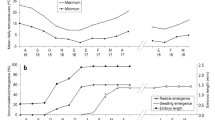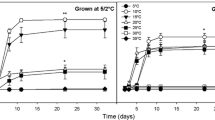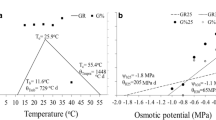Abstract
Germination responses ofMallotus japonicus (Thumb). Muell. Arg. seeds to temperature revealed a gap-detecting mechanism in the seed germination of the species. Among various constant and alternating temperatures examined in the range from 12–40°C, only very limited temperature regimes were found to be favourable for seed germination, specifically, alternating temperatures between 18–32°C and 28–40°C. A single several-hour higher-temperature (32–40°C) treatment could also induce the germination of seeds which had been imbibed for several days at a constant temperature in the range of 20–26°C, suggesting that there is a process requiring higher temperature among the overal germination processes. Seeds located at or near the surface of denuded soil would have a good chance of experiencing such a temperature change when several rainy days are followed by fine weather, while seeds beneath close vegetation would not. On the other hand, the pressence or absence of light or a simulated ‘canopy ligh’ had little effect on the germination. Therefore, it was concluded that the seeds ofM. japonicus have a ‘gapdetecting mechanism’ in the form of a higher-temperature requirement of a certain process involved in the overall germination processes.
Similar content being viewed by others
References
Bewley, J. D., &Black, M. (1982) Physiology and Biochemistry of Seeds in Relation to Germination. II. Viability, Dormancy and Environmental Control, Springer-Verlag, Berlin, Heidelberg & New York.
Fenner, M. (1980) The inhibition of germinationBidens pilosa seeds by leaf-canopy shade in some natural vegetation types. New phytol. 84: 95–101.
Frankland, B. (1981) Germination in shade. “Plants and the Daylight Spectrum” (ed. Smith, H.), 187–204. Academic Press, London, New York, Toronto, Syndney & San Francisco.
Grime, J. P. (1979) Plant Strategies and Vegetation processes. Chichester, New York, Brisbane & Toronto.
—.Mason, G., Curtis, A. V., Rodman, J., Band, S. R., Mowforth, M. A. G., Neal, A. M. &Shaw, S. (1981) A comparative study of germination characteristics in a local flora. J. Ecol.69: 1017–1059.
Hall, J. B. &Swaine, M. D. (1982) Seed stocks in Ghanaian forest soils. Biotropica12: 256–263.
Horikawa, Y. (1972) Atlas of the Japanese Flora. An Introduction to Plant Sociology of East Asia. Gakken, Tokyo.
Nagano, M. & Umehara, T. (1980) A study on the rapid recovery of vegation on denuded areas by applying surface soil containing burie seed collected from nearby forests. “Studies on the Promotion of Recovery of Natural Vegetation in Mino-o Dam Area”, 6–113. Osaka prefecture, Osaka, Japan (In Japanese).
Naka, K. &Yoda, K. (1984) Community dynamics of evergreen broadleaf forests in southwestern Japan. II. Species composition and density of seeds buried in the soil of a climax evergreen oak forest. Bot. Mag. Tokyo97:61–79.
Nakagoshi, N. (1984) Buried viable seed populations in forest communities on the Hiba Mountains, southewestern Japan. J. Sci. Hiroshima Univ. Series B, Div. 2 (Botany)9:1–59.
Probert, R. J., Smith, R. D. &Brich, P. (1985) Germination responses to light and alternating temperatures in European populations ofDactylis glomerata L. I. Variability in relation to origin. New Phytol.99:305–316.
Putz, F. E. (1983) Treefall pits and mounds, buried seed, and the importance of soil disturbance to pioneer trees on Barro Colorado island, Panama, Ecol.64:1069–1074.
Smith, H. (1982) Light quality, photoperception, and plant strategy. Ann. Rev. Plant Physiol.33:481–518.
Solbrig, O. T. (1980) Demography and natural selection. “Demography and Evolution in Plant Populations” (ed. Solbrig, O. T.), 1–20, Blackwell, Oxford.
Strickler, G. S. &Edgerton, J. (1976) Emergent seedlings from coniferous litter and soil in eastern Oregon, Ecol.57:801–807.
Thompson, K. &Grime, J. P. (1983) A comparative study of germination responses to diurnally-fluctuating temperatures. J. Appl. Ecol.20:141–156.
— &Whatley, J. C. (1984) A thermogradient bar apparatus for the study of the germination requirements of buried seedsin situ. New Phytol.96:459–471.
Thompson, P. A. (1969) Germination ofLycopus europaeus. L. inresponse to fluctuating temperatures and light. J. Exp. Bot.20:1–11.
—. (1974) Germination of celery (Apium graveolens L. in response to fluctuating temperatures tures. J. Exp. Bot.25:156–163.
Totterdell, S. &Roberts, E. H. (1980) Characteristics of alternating temperatures which stimulate loss of dormancy in seeds ofRumex obutusifolius L. andRumex crispus L. Plant, Cell & Env.3:3–12.
Vazquez-Yanes, C. &Smith, H. (1982) Phytochrome control of seed germination in the tropical rain forest pioneer treesCecropia obtusifolia andPiper auritum and its ecological significance. New Phytol.92:477–485.
Washitani, I. &Saeki, T. (1984) Leaf-canopy inhibition of germination as a mechanism for the disappearance ofAmaranthus patulus Bertol. in the second year of a secondary sucession. Jap. J. Ecol.34:55–61.
— &Takenaka, A. (1986) ‘Safe sites’ for the seed germination ofRhus javanica: a characterization by responses to temperature and light. Ecol. Res.1:71–82.
Whipple, S. A. (1978) The relationship of buried germinating seeds to vegetation in an old-growth Colorado subalpine forest. Can. J. Bot.56:1505–1509.
Williams, E. D. (1983) Effects of temperature fluctuation, red and far-red light and nitrate on seed germination of five gasses. J. Appl. Ecol.20:923–935.
Author information
Authors and Affiliations
About this article
Cite this article
Washitani, I., Takenaka, A. Gap-detecting mechanism in the seed germination ofMallotus japonicus (Thunb.) Muell. Arg., a common pioneer tree of secondary succession in temperate Japan. Ecol. Res. 2, 191–201 (1987). https://doi.org/10.1007/BF02349773
Accepted:
Issue Date:
DOI: https://doi.org/10.1007/BF02349773




